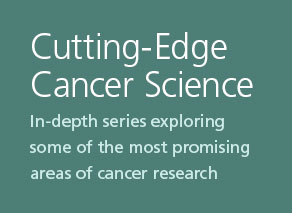Personalized Medicine: Redefining Cancer and Its Treatment
This story is part of the American Cancer Society’s Cutting-Edge Cancer Science series, which is exploring some of the most promising areas of cancer research in depth.

This is part 1 of a 3-part feature exploring what personalized medicine means for cancer patients. Part 2 covers where personalized cancer stands today and part 3 reviews personalized medicine for cancer prevention.

The type of cancer a person has – and how it gets treated – is no longer just about where in the body the cancer started, such as in the breast or lungs or the colon. More so now than ever, when doctors decide how to attack a cancer, they are arming themselves with a wealth of knowledge about the specific molecular and genetic makeup of their patient’s tumor.
Many researchers and cancer centers are already embracing this personalized approach to cancer care. Though still in early stages, this field of work is moving and improving at a rapid pace, and just got a boost from President Barack Obama, with his announcement of a $215 million investment to launch the Precision Medicine Initiative. The initiative aims to speed up progress toward personalized medicine for all.
Delivering on the promise of personalized medicine, though, is going to take a massive effort from not just researchers and doctors, but also from health insurers, pharmaceutical companies, and government agencies, among others.
Personalized vs. Precision Medicine
The terms personalized medicine and precision medicine are often used interchangeably. While experts are not in agreement as to whether the two terms mean the same thing, the definitions of personalized medicine and precision medicine seem to be merging. Even President Obama, in his remarks about the Precision Medicine Initiative, commingled the two: “Precision medicine – in some cases, people call it personalized medicine – gives us one of the greatest opportunities for new medical breakthroughs that we have ever seen.”
The meaning of the terms – and source of the forthcoming breakthroughs – is essentially the ability to tailor treatments, as well as prevention strategies, to the unique characteristics of each person.
The president’s initiative, and the terms themselves, extend beyond cancer, and are meant to encompass all health issues. Cancer, though, is a major focus of the Precision Medicine Initiative, especially its nearer-term goals.
Taking Steps Toward Personalized Medicine
A lot of work has already been done to make cancer care more personalized, partly because cancer is so complex that it has forced scientists to dig deep into the inner workings of human cells to figure out cancer’s causes.
Decades of advances in basic science, technology, therapeutics, and the understanding of the genetic causes of cancer have coalesced in recent years to make personalized cancer care possible.
What researchers have learned over time is that cancer can arise from any number of genetic malfunctions, and often is due to a combination of errors, that ultimately lead to the out-of-control cell growth that causes tumors to grow and spread.
This knowledge has allowed doctors to sometimes move cancer treatment from a broad-brush approach – using radiation, surgery, and chemotherapy to wipe out cancer and taking out normal healthy cells in the process – to a more targeted technique.
Targeted therapy took off in the late 1990s and early 2000s, with the advent of drugs that interfere with the essential functions of cancer cells in order to get them to die off – such as by stopping cancer cells from dividing or keeping tumors from making the new blood vessels they need to grow.
Targeted drugs gave doctors the ability to start customizing treatments, to a certain degree, to the patient. But researchers discovered that – like radiation and chemo – targeted therapies aren’t one size fits all. Every patient has a unique set of factors driving their cancer. In other words, there are multiple targets in each patient that may need to be hit. This is where tumor profiling comes in.
Better Treatments, Fewer Side Effects
The idea of analyzing an individual patient’s tumor to determine what combination of drugs will work best is what personalized cancer care is all about. With this level of specificity also comes greater potential to decrease toxic side effects. “The overall toxicity to patients should be reduced because you are more likely to use the best collection of drugs the first time around,” says William Phelps, PhD, the director of preclinical and translational cancer research at the American Cancer Society.
When it comes to cancer, personalization can take several different forms currently. It might mean:
- testing a person’s cancer to find out if a certain type of treatment will work on it,
- looking at a person’s genetics to decide whether he or she can handle a specific medicine, or
- conducting a genetic test to determine if a person has certain genetic mutations that could put them at a higher risk for developing cancer.
The ability to look at the genetic makeup of a person’s tumor in a relatively quick and low-cost manner has been one of the most important contributors to progress in personalized cancer care. “A major technological advance that has made my work possible was the tumbling down in cost and time of sequencing patients’ tumors,” says Ross Cagan, Ph.D., director of the Mount Sinai Center for Personalized Cancer Therapeutics.
Lower cost, though, does not yet mean affordable for everyone.
Bottom Line
A 2011 National Research Council report on precision medicine explains why these advances matter, by contrasting breast cancer treatment today and 25 years ago. Twenty-five years ago, women had few treatment options – basically hormone therapy or chemo, both of which could have significant side effects.
Today, many patients have treatment options based on the particular markers in their tumors. These patients can get better, more specific treatments, which might also have fewer side effects.
This is one of the major goals of personalized medicine – give cancer patients the treatments that are most likely to work on their particular cancer with fewer harmful side effects.
- For researchers
American Cancer Society news stories are copyrighted material and are not intended to be used as press releases. For reprint requests, please see our Content Usage Policy.



